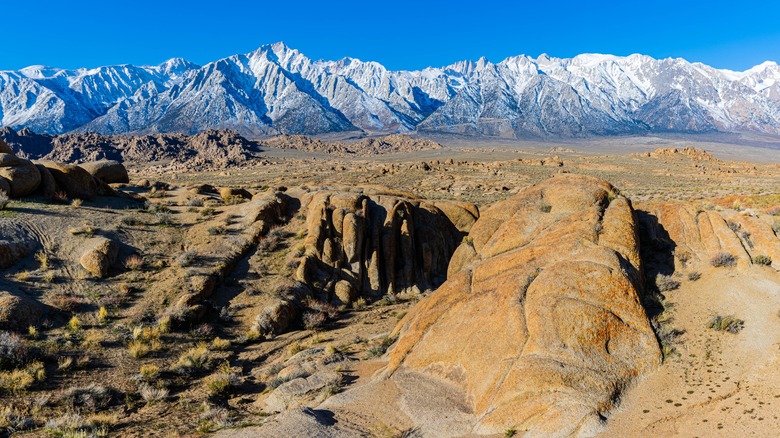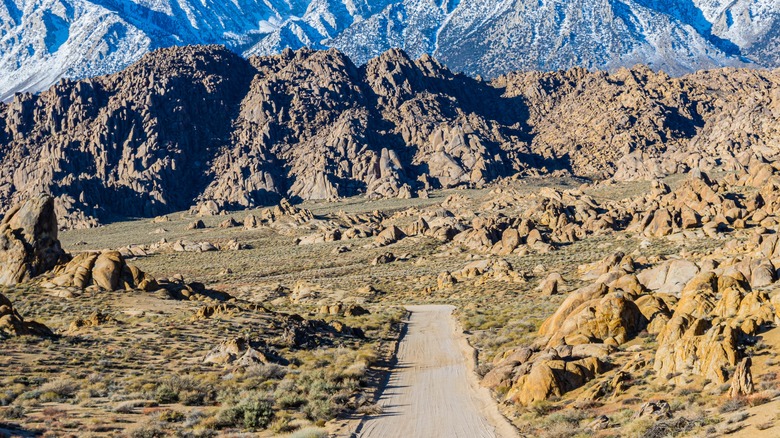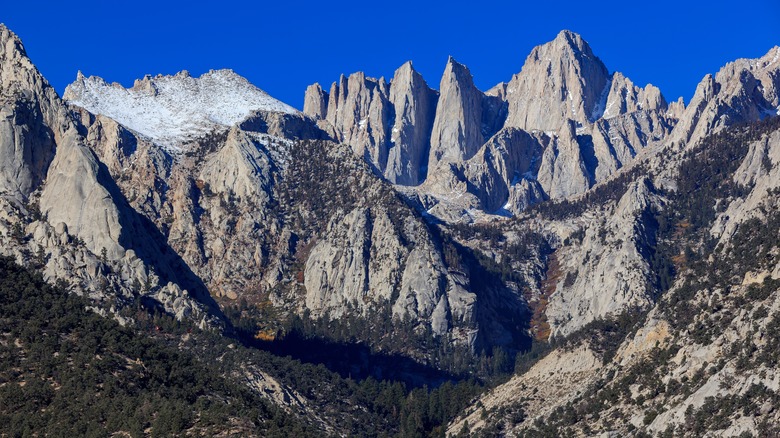An Under-The-Radar Region Is One Of California's Most Cinematic Mountain Destinations
Just like the celebs who have their names brandished on Hollywood Boulevard, California itself is a bit of a movie star. The Golden State has featured in many a blockbuster in its time, and recognizable filming locales are everywhere. You could sling the pistol at the quirky desert destination of Pioneertown, a regular backdrop to Westerns. You could drop in for a drink at LA's iconic Koreatown bar, The Prince, which featured in HBO's hit "Mad Men" and more. Then there's the Alabama Hills, which reign as one of the most popular cinema locations of all.
A whopping 400 separate films have been made using the unique backdrop of these hills, which spread through the dusty confines of the Owens Valley below the mighty Sierra Nevada. Of course, the setting is suitably jaw-dropping. You've got the jagged top of Mount Whitney — the highest mountain in the contiguous United States — keeping watch to the west, while the ochre-hued ridges of the Panamint Range pave the way into the scorching Death Valley National Park to the east.
These days, the Alabama Hills are a designated National Scenic Area where visitors can trace the ghosts of great actors past and spy out filming spots used in countless Silver Screen hits. Dirt roads and trails weave and pierce through the wilderness, leading to camp pitches and photo locations so ridiculously stunning you'll feel like a big-screen director yourself. Have the camera at the ready for the drive in: The route is spectacular, coursing toward the snow-capped Sierra Nevada on Whitney Portal Road after leaving the majestic 395 highway, itself a scenic romp through some of Cali's most iconic mountain and desert landscapes.
Play a leading role in multiple movies in the Alabama Hills
Film buffs will find their eyes darting all over the place in the Alabama Hills. Veer off onto aptly named Movie Road to launch an odyssey through the history of Hollywood. There's a self-guided drive route that will reveal various locations used in classics — from a rocky cliff where a wagon crashes in "Hell Bent for Leather" to the site of a village from the swashbuckling "Gunga Din" back in 1939. Along the way, keep watch for monumental rocks named after the legends who have filmed here. There's the Gene Autry rock and the Gary Cooper rock, each standing tall and proud above the surrounding dust bowls and boulders.
Prefer your films in full color? You can survey the scrublands where modern maestro Quentin Tarantino directed the opening scenes of his Oscar-winning opus "Django Unchained." Alternatively, you can also stand where Tony Stark — aka Iron Man — was ambushed by an Afghan terror cell, and even cross the same rocky track as a certain Maximus Decimus Meridius on his long ride home in Ridley Scott's 2000 epic, "Gladiator." It's endless.
To cap it all off, the local town of Lone Pine — just a few minutes down the road — is home to the Museum of Western Film History. Go there to see groundbreaking camera rigs used in the filming of historic cowboy flicks, gear worn by John Wayne (heard of him?), and even Dr. King Schultz's quirky wagon from "Django."
Mountains swirl around the Alabama Hills
Although the rust-colored boulders of the Alabama Hills look very different from the cloud-shattering peaks on the horizon, they were actually forged by the same geological movements that made the high Sierra Nevada. In fact, the gateway to the epic hike up Mount Whitney is less than 9 miles up the road. It begins in Whitney Portal before clambering up to 14,494 feet above sea level — the pinnacle of the lower 48 states. Permits are required for that, and can be notoriously hard to come by.
The good news is that the Alabama Hills have some pretty spectacular hiking paths of their own. Short loops dip in and out of the scenic area from Movie Road, revealing age-worn rock formations like the incredible Mobius Arch. Photo of the snowy sierras framed perfectly in a loop of honey-tinged stone, anyone?
For accommodation, the nearby Lone Pine Campground generally opens in the middle of April and closes again sometime in October. It offers pitches with head-on views of Mount Whitney and sits at the base of an up-and-back hike that goes from the valley bottom to Whitney Portal, zigzagging up the eastern slope of the sierras through pine thickets and over gurgling rivers. Watch out, though: It's bear and mountain lion country!


